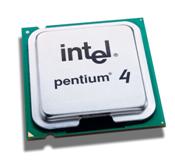Intel Pentium 4 6XX Sequence and 3.73GHz Extreme Edition Processors
New P4 Architectural Features
With this processor launch, Intel brings forth 64-bit OS and application support with EM64T extensions. In addition, the company has a few other tricks up its sleeve aimed to keep power/thermals in check and security threats on the outside looking in.
|
Intel EM64T - Extended Memory 64 Technology
32-bit operating systems have a limitation of 4GB of memory address space. This limitation is put upon every device or application running in the system that initiates IOs into system memory, such as graphics cards and Ethernet controllers. Each device shares a piece of that 4GB of available memory space in 32-bit mode. However, a 64-bit architecture will expand addressable memory space from 4GB to a possible 256 terabytes, which obviously allows for an exponentially larger shared memory space for system IOs.
Where 32-bit workstations and servers are currently typically offered with 4GB of system RAM, many OEMs will be offering 16GB and higher Intel Pentium 4 and Xeon configurations moving forward. Incidentally Intel's Xeon processor lineup has had EM64T support for some time and even older Prescott core CPUs have had this feature, although Intel hadn't enabled it until this processor launch.
EM64T is nearly completely compatible with AMD64 technology and is simply an extension of the 32-bit x86 or IA-32 instruction set. Although Intel will not openly acknowledge this, it is a very close facsimile to what AMD has offered for some time in the Athlon 64 and is very different from Intel's own IA-64 instruction set that Intel brought to market with the Itanium. As a result, EM64T-capable processors cannot run the same software, OS, or applications developed for IA-64. With the success of the Athlon 64, especially in the workstation/server markets, Intel simply had to respond to this competitive threat. Although it's a bitter pill to swallow, Goliath bowed to David in this battle, and Intel followed a competitor's path in X86 CPU technology, something the company hasn't had to do for a very long time.
Intel Enhanced SpeedStep Power Savings and Thermal Control
EIST or Enhanced Intel SpeedStep Technology, is an Intel innovation that Intel has been developing in its mobile Pentium processor designs for some time now. It's a method of allowing the system to dynamically adjust processor frequency as well as voltage. Requirements to support EIST are dynamic VID support on the motherboard, based on the VRD10 power array specification, BIOS EIST support, OS Support for EIST, and System Configuration to enable EIST. Virtually all motherboard manufacturers offering i915 and 9125X designs will have built-in BIOS EIST support. Furthermore, here is a current list of operating systems that support EIST:
•Microsoft Windows XP SP2
•Microsoft Advanced Server 2003 SP1 (builds > 1218)
•General Linux 2.6.9 kernel and beyond
What actually happens in the case of a Pentium 660, for example, is that at very light workloads or an idle state, the processor kicks down to a 14X multiplier for 2.8GHz and core voltage is brought down in scale. During medium or heavy workloads, the processor returns to full specification speed in the case of a P4 660, which is 3.6GHz. We'll show this in action later in this article. This technology was absolutely pivotal for Intel to realize more reasonable thermal characteristics because these new Prescott 2M cores, with their additional L2 cache on board, drive core temperatures to nearly alarming levels.
Execute Disable Bit For Security
Certain viruses that compromise a system can create buffer overflows by swamping a system processor with code. This overflow can potentially allow the worm or virus to propagate itself across a network of systems infecting other computers in the network. Execute Disable Bit technology was developed by Intel initially for its Itanium processor line, aimed at preventing these types of buffer overflow attacks. Now also available in these new Pentium 4 processors, the Execute Disable Bit allows the processor to designate areas in system memory where application code can run and areas where it can't. When a virus or worm tries to compromise the memory buffer, the system processor stops the code execution, halting the worm or virus in its tracks.
2MB of L2 Cache
Intel has recently taken another path to enhancing processor performance beyond just brute force clock speed increases. Larger on-chip cache regions allow for significantly lower latency memory access in support of the P4 Prescott 2M core. Sufficient memory bandwidth is a significant system bottleneck in general, and the Prescott 2M core, with its 31-stage pipe, needs all the bandwidth it can get. 2MB of L2 cache should provide a measurable performance gain over current Prescott core P4 CPUs and afford this processor core a bit more headroom in gaming and multimedia applications. Comparatively, the Prescott 2M core that these new 6XX Sequence and 3.73GHz Extreme Edition CPUs are based on have 512KB less processor cache on board than a Gallatin core Extreme Edition 3.4 or 3.46GHz P4, which also has a much shorter 20-stage pipeline. Current P4 EE chips have 512KB L2 cache and another full 2MB of L3 cache. It should be interesting to see how these two new architectures match up and how well the new Extreme Edition P4 fares against its brethren Gallatin P4 EE chip.








